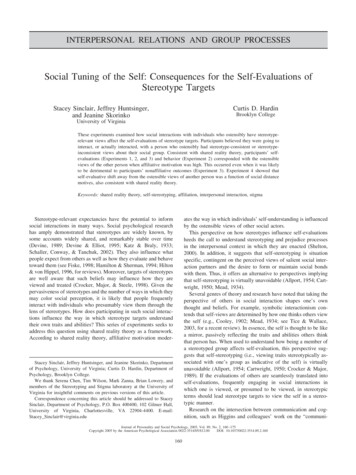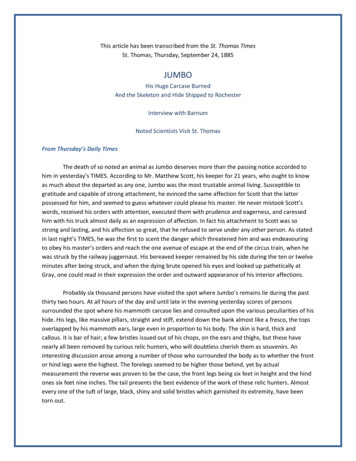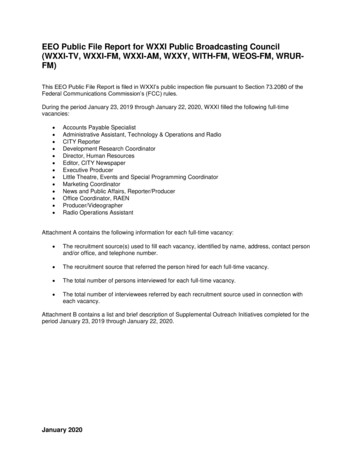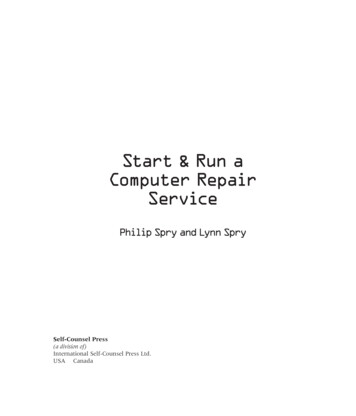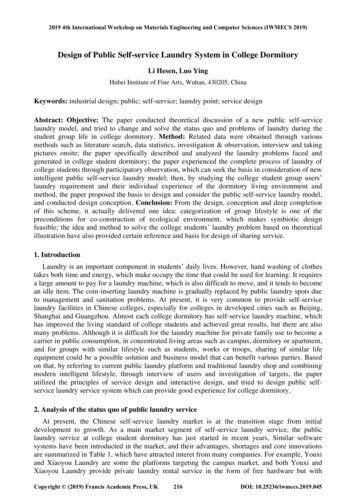
Transcription
2019 4th International Workshop on Materials Engineering and Computer Sciences (IWMECS 2019)Design of Public Self-service Laundry System in College DormitoryLi Hesen, Luo YingHubei Institute of Fine Arts, Wuhan, 430205, ChinaKeywords: industrial design; public; self-service; laundry point; service designAbstract: Objective: The paper conducted theoretical discussion of a new public self-servicelaundry model, and tried to change and solve the status quo and problems of laundry during thestudent group life in college dormitory. Method: Related data were obtained through variousmethods such as literature search, data statistics, investigation & observation, interview and takingpictures onsite; the paper specifically described and analyzed the laundry problems faced andgenerated in college student dormitory; the paper experienced the complete process of laundry ofcollege students through participatory observation, which can seek the basis in consideration of newintelligent public self-service laundry model; then, by studying the college student group users’laundry requirement and their individual experience of the dormitory living environment andmethod, the paper proposed the basis to design and consider the public self-service laundry model,and conducted design conception. Conclusion: From the design, conception and deep completionof this scheme, it actually delivered one idea: categorization of group lifestyle is one of thepreconditions for co-construction of ecological environment, which makes symbiotic designfeasible; the idea and method to solve the college students’ laundry problem based on theoreticalillustration have also provided certain reference and basis for design of sharing service.1. IntroductionLaundry is an important component in students’ daily lives. However, hand washing of clothestakes both time and energy, which make occupy the time that could be used for learning. It requiresa large amount to pay for a laundry machine, which is also difficult to move, and it tends to becomean idle item. The coin-inserting laundry machine is gradually replaced by public laundry spots dueto management and sanitation problems. At present, it is very common to provide self-servicelaundry facilities in Chinese colleges, especially for colleges in developed cities such as Beijing,Shanghai and Guangzhou. Almost each college dormitory has self-service laundry machine, whichhas improved the living standard of college students and achieved great results, but there are alsomany problems. Although it is difficult for the laundry machine for private family use to become acarrier in public consumption, in concentrated living areas such as campus, dormitory or apartment,and for groups with similar lifestyle such as students, works or troops, sharing of similar lifeequipment could be a possible solution and business model that can benefit various parties. Basedon that, by referring to current public laundry platform and traditional laundry shop and combiningmodern intelligent lifestyle, through interview of users and investigation of targets, the paperutilized the principles of service design and interactive design, and tried to design public selfservice laundry service system which can provide good experience for college dormitory.2. Analysis of the status quo of public laundry serviceAt present, the Chinese self-service laundry market is at the transition stage from initialdevelopment to growth. As a main market segment of self-service laundry service, the publiclaundry service at college student dormitory has just started in recent years, Similar softwaresystems have been introducted in the market, and their advantages, shortages and core innovationsare summarized in Table 1, which have attracted interet from many companies. For example, Youxiand Xiaoyou Laundry are some the platforms targeting the campus market, and both Youxi andXiaoyou Laundry provide private laundry rental service in the form of free hardware but withCopyright (2019) Francis Academic Press, UK216DOI: 10.25236/iwmecs.2019.045
service charge. Both services can effectively solve the problem of “difficulty to do laundry“ incollege student dormitory, which can save the time and energy spent on laundry by the students.Through related service management, it has also effectively prevented the sanitation problem, andaccumulated certain experiences of success. The laundry service platform, such as the brands ofYouxi and Xiaoyou Laundry, can provide laundry machine rental service to students, and althoughit has solved the problem of private laundry, there is still a problem that the laundry machine takesroom of dormitory. Another example is the laundry platform that applies to all people-HaierLaundry and Yixiba. Haier Laundry provides self-service laundry, collection and delivery service;Yixiba has introduced the common laundry model of foreign country into China, and it tries toprovide a new lifestyle. However, these platforms involve high service charges, which do not applyto the low-end consumers. In our daily lives, with the popularization and introduction of mobileintelligent device, intelligent control has been gradually increased in many laundry serviceplatforms, which has established intelligent laundry service.3. Basis for the design and consideration of public self-service laundry service in collegedormitory3.1 User featuresAs the target user group of public self-service laundry system on campus, the college studentshave their own special features, which are mainly represented by: in college, most students woulduse their spare time to improve their ability or in entertainment, and very few would spend timeorganizing; most college students are only child at home, their independent organization ability isweak as they grow up, and they need long time for adaption after they go to college; at present, thecollege students would generally choose a lifestyle that can provide independence and convenienceand save time, so that they can spend more energy in study, which can alleviate the burden ofchores; the group of college students who focus on study generally live on the allowances fromtheir parents, and unavoidable social consumption for basic necessities of life are their mainexpenditures, so different from other social groups, the special consumption of college studentsdecides that “cost effective“ consumption is the main factor that they consider; in this new age, thecollege students have strong desire for exploration and ability of learning, they have strongadaptability to intelligent consumption, and in particular, various intelligent payment methods havecreated a new lifestyle on campus, which has provided more options to the college students.According analysis of data obtained through questionnaire survey, it can be seen that most studentshave the requirement to wash their clothes, pants, socks, etc., and some students even have therequirement to wash their shoes or special garments. In order to meet most students’ laundryrequirement, some colleges provide laundry machine service paid by putting in coins or using bankcard in the dormitory, and the laundry mode is relative simple, easy for operation and veryconvenient; later, the laundry shop or dry cleaning shop which provides human service wasintroduced, which can satisfy the students’ various requirements for laundry services, but the drycleaning shop which charges based on laundry type and item is much more expensive than theprevious favored laundry machine paid by inserting coins, so the dry cleaning shop off campus hasnot become the main option of college students. Based on the college students’ rigid demand forlaundry, the business model of relative cheap but mature public laundry point has been introducedon campus. Therefore, with intelligent mobile terminal APP as the operational platform, the publicself-service laundry service model is not only feasible, but can also satisfy the college students’laundry requirement based on their current lifestyle.3.2 Behavior processGenerally speaking, the laundry behavior process can be described as: (1) Collect dirty laundry;(2) Put dirty laundry into the laundry machine; (3) Put water and detergent; (4) Clean with laundrymachine, dewater and complete; (5) Take out the laundry, put it into the dryer for drying or take thelaundry back to air it. Through observation and interview of college students during the process of217
doing laundry, we found that when there were many students doing laundry and when the laundrytime was concentrated, the main problems were as follows. First of all, it was the crowdedness oflaundry. Most students did laundry at their spare time, the time was highly consistent, and no matterwhether the student used the laundry machine bought in the dormitory or coin-inserting laundrymachine, or had their laundry done in off campus drying cleaning shop, they needed to wait. Atsome public laundry points, some students were not willing to wait in line and used basin instead, asa result, the environment near laundry machine became chaotic and disordered, and some studentsmay jump the line because there was no management onsite. Secondly, it was the waiting problemduring laundry. In general, it took 25-45 minutes to do laundry, which indicates there was waitingduring the process of doing laundry, and at public laundry points, the problem that the users hadnothing to do during the waiting was obvious. The users whose dormitory was far from the laundrypoint would choose to spend their time around the laundry point in order to prevent going back andforth and climbing stairs. Thirdly, it was the problem to take out laundry. Although the laundry timecan be estimated, many users failed to take out their laundry in time, and as a result, the cleanedlaundry was left in the laundry machine, which occupied the equipment. Therefore, the design ofnew public self-service laundry service system should aim to improve the efficiency of user’slaundry behavior process, which can effectively alleviate the problems mentioned above.3.3 Service scenariosRegardless of the difference in building construction and planning and the scale of laundry room,as public hardware facility, the laundry machine, equipment and related supporting facilities withinthe public laundry point should be solid and durable, and related personnel should be assigned toprovide regular maintenance and management. In particular, when there are many people waitingon the line, ordered management should be provided to ensure orderly laundry service of users.Therefore, in order to reasonably arrange the laundry space and ensure efficiency laundry, thequantity of laundry points should be designed according the number of students living in collegedormitories and laundry demand, and the quantity of laundry devices in laundry point should beestimated according to regular number of people doing laundry, including the laundry machine,drier, shoe cleaning machine, etc. The hardware facilities in public self-service laundry point shouldbe simplified. In the self-service scenarios with no other people participating, there should beobvious guiding system to provide reminder, and from when the user enters the self-service laundrypoint, to when the laundry equipment starts operation and until when the user leaves the self-servicelaundry point, there should be clear reminder of related steps of laundry procedure, which canreduce the difficulty for user in self-service scenario and improve the laundry efficiency. Differentequipment areas should be equipped with corresponding instructions for operation withillustrations, which will be easy to understand. In the service scenarios, there should be supportingnetwork environment. In order to ensure that the public self-service laundry points of the samebrand have the same visual features, the indoor space and outdoor environment should adoptuniform design style, which will be easy for identification and interpretation of design concept.3.4 Service blueprintBefore doing laundry, the user can search for associated self-service laundry points through thesoftware system. The software system will obtain the user data and confirm the current location ofuser based on authorization and consent; the background navigation system will select and showseveral self-service laundry points near the user for reference, and intelligently recommend theoptimal choice; if there is no idle laundry equipment in nearby laundry points, the user can line upor reserve service in the software system. The real-time synchronous operation of software systemand equipment in laundry point cam ne supported through update of background data, and oncethere is idle laundry equipment, the software system will send reminder to notify the user. Afterreceiving the laundry command, the user arrives at the laundry point, and conducts related operationof laundry according to the illustration and instruction of service scenarios provided in the laundrypoint. The user should connect equipment according to the command (through measure such asscanning a QR code), seek cleaning model of laundry equipment in the software system and make218
payment. After the successful payment, the background intelligent control system will start thelaundry equipment, the software will show the operation of laundry equipment fed back bybackground in a real-time and synchronous manner, and the user does not need to wait for thelaundry to be done beside the laundry equipment. As the laundry is about to be done, the softwaresystem will send reminder to notify the user to take out the laundry at the laundry point, which canprevent remained laundry from affecting the laundry operation of next user .4. Design cases of public self-service laundry service4.1 Problem descriptionTake the dormitory in a college in Guangdong Province for example. Four to six students livedin one dormitory, almost every dormitory bought a laundry machine, some place
As the target user group of public self-service laundry system on campus, the college students have their own special features, which are mainly represented by: in college, most students would use their spare time to improve their ability or in entertainment, and very few would spend time organizing; most college students are only child at home, their independent organization ability is weak .





